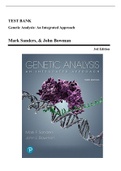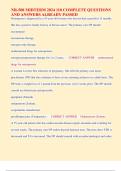TEST BANK
Genetic Analysis: An Integrated Approach
Mark Sanders, & John Bowman
3rd Edition
,Table of Contents
Chapter 01 The Molecular Basis of Heredity, Variation, and Evolution 1
Chapter 02 Transmission Genetics 21
Chapter 03 Cell Division and Chromosome Heredity 41
Chapter 04 Gene Interaction 59
Chapter 05 Genetic Linkage and Mapping in Eukaryotes 81
Chapter 06 Genetic Analysis and Mapping in Bacteria and Bacteriophages 102
Chapter 07 DNA Structure and Replication 122
Chapter 08 Molecular Biology and Transcription and RNA Processing 138
Chapter 09 The Molecular Biology of Translation 156
Chapter 10 Eukaryotic Chromosome Abnormalities and Molecular Organization 172
Chapter 11 Gene Mutation, DNA Repair, and Homologous Recombination 190
Chapter 12 Regulation of Gene Expression in Bacteria and Bacteriophages 203
Chapter 13 Regulation of Gene Expression in Eukaryotes 227
Chapter 14 Forward Genetics and Recombinant DNA Technology 241
Chapter 15 Recombinant DNA Technology and Its Applications 254
Chapter 16 Genomics-Genetics from a Whole-Genome Perspective 270
Chapter 17 Cytoplasmic Inheritance and the Evolution of Organelle Genomes 284
Chapter 18 Developmental Genetics 298
Chapter 19 Genetic Analysis of Quantitative Traits 313
Chapter 20 Population Genetics and Evolution at the Population, Species, and Molecular
Levels 328
Application A Human Hereditary Disease and Genetic Counseling 346
Application B Human Genetic Screening 352
Application C The Genetics of Cancer 358
Application D Human Evolutionary Genetics 364
Application E Forensic Genetics 370
,______________________________________________________________________________________________
Test Bank - Genetic Analysis: An Integrated Approach, 3rd Edition (Sanders, 2019)
Genetic Analysis: An Integrated Approach, 3e (Sanders)
Chapter 1 The Molecular Basis of Heredity, Variation, and Evolution
1.1 Multiple-Choice Questions
1) Sexual reproduction uses ________ to generate ________ gametes, which join at fertilization.
A) meiosis; haploid
B) mitosis; haploid
C) meiosis; diploid
D) mitosis; diploid
E) mitosis; identical
Answer: A
Section: 1.1
Skill: Remembering/Understanding
2) When a diploid cell divides by mitosis, the result is ________.
A) identical haploid cells
B) identical diploid cells
C) unique diploid cells
D) unique haploid cells
E) a zygote
Answer: B
Section: 1.1
Skill: Remembering/Understanding
3) Modern genetics consists of three major branches. Which of these branches, also known as
"transmission genetics," involves the study of the transmission of traits and characteristics in
successive generations?
A) evolutionary
B) Mendelian
C) molecular
D) population
E) reproductive
Answer: B
Section: 1.1
Skill: Remembering/Understanding
4) You identify a new unicellular organism with multiple chromosomes organized by proteins
within the cell's nucleus. Into which of the three domains of life might this organism fit?
A) Archaea
B) Bacteria
C) Eukarya
D) Archaea or Bacteria
E) Archaea or Eukarya
Answer: C
Section: 1.1
Skill: Applying/Analyzing
______________________________________________________________________________________________
1|Page
https://www.stuvia.com/en-us/user/AllStudyGuides
,______________________________________________________________________________________________
Test Bank - Genetic Analysis: An Integrated Approach, 3rd Edition (Sanders, 2019)
5) Watson and Crick used evidence from several studies to determine the structure of DNA.
What conclusion were they able to draw from Rosalind Franklin's X-ray diffraction data,
specifically?
A) DNA consists of four types of nucleotide bases: A, T, C, and G.
B) DNA nucleotides form complementary base pairs.
C) Adenine pairs with thymine and cytosine pairs with guanine when they are on opposite DNA
strands.
D) DNA is a duplex, with two strands forming a double helix.
E) The DNA strands are antiparallel, and the strands are held together by hydrogen bonds.
Answer: D
Section: 1.2
Skill: Remembering/Understanding
LO: S1.2
6) What kind of bond is formed between the 5′ phosphate group of one nucleotide and the 3′
hydroxyl (OH) group of the adjacent nucleotide?
A) ionic bond
B) phosphodiester bond
C) hydrogen bond
D) disulfide bond
E) hydroxyl bond
Answer: B
Section: 1.2
Skill: Remembering/Understanding
LO: S1.2
7) What kind of bond is formed between complementary base pairs to join the two DNA strands
into a double helix?
A) ionic bond
B) phosphodiester bond
C) hydrogen bond
D) disulfide bond
E) peptide bond
Answer: C
Section: 1.2
Skill: Remembering/Understanding
LO: S1.2
______________________________________________________________________________________________
2|Page
https://www.stuvia.com/en-us/user/AllStudyGuides
,______________________________________________________________________________________________
Test Bank - Genetic Analysis: An Integrated Approach, 3rd Edition (Sanders, 2019)
8) Identify which of the following includes three possible components of a RNA nucleotide?
A) deoxyribose, guanine, phosphate group
B) deoxyribose, uracil, phosphate group
C) ribose, thymine, phosphate group
D) deoxyribose, cytosine, phosphate group
E) ribose, adenine, phosphate group
Answer: E
Section: 1.2
Skill: Remembering/Understanding
LO: S1.2
9) What chemical group appears on the 5' carbon of a DNA nucleotide?
A) carboxyl group
B) phosphate group
C) amino group
D) hydroxyl group
E) nitrogenous base
Answer: B
Section: 1.2
Skill: Remembering/Understanding
LO: S1.2
10) If a eukaryotic chromosome was composed of 20% adenine, how much cytosine should
theoretically be present in that same chromosome?
A) 30%
B) 20%
C) 60%
D) 40%
E) 10%
Answer: A
Section: 1.2
Skill: Applying/Analyzing
LO: G4, S1.2
______________________________________________________________________________________________
3|Page
https://www.stuvia.com/en-us/user/AllStudyGuides
,______________________________________________________________________________________________
Test Bank - Genetic Analysis: An Integrated Approach, 3rd Edition (Sanders, 2019)
11) Use the data in the following table to determine which nucleic acid sample can be ALL of
the following 4 types: double-stranded DNA, single-stranded DNA, double-stranded RNA, or
single-stranded RNA.
Nucleic Acid Sample Data
Sample 1 25% of the bases are thymine
Sample 2 35% of the bases are adenine
Sample 3 25% of the bases are uracil
Sample 4 55% of the bases are cytosine
50% of the five-carbon sugars are
Sample 5
deoxyribose
A) Sample 1
B) Sample 2
C) Sample 3
D) Sample 4
E) Sample 5
Answer: B
Section: 1.2
Skill: Applying/Analyzing
LO: G1, S1.2
12) What is the sequence and polarity of the DNA strand complementary to the strand
5' AAATGTCCATGC 3'?
A) 5' TTTACAGGTACG 3'
B) 3' AAATGTCCATGC 5'
C) 3' TTTACAGGTACG 5'
D) 5' UUUACAGGUACG 3'
E) 3' UUUACAGGUACG 5'
Answer: C
Section: 1.2
Skill: Applying/Analyzing
LO: 1.3b
13) Messenger RNA (mRNA) is ________.
A) the major structural material making up ribosomes
B) the molecule that carries the genetic information from DNA and is used as a template for
protein synthesis
C) the major structural component of chromosomes
D) a molecule that incorporates a specific amino acid into the growing protein when it
recognizes a specific group of three bases
E) the monomer of polypeptides
Answer: B
Section: 1.3
Skill: Remembering/Understanding
LO: S1.3a
______________________________________________________________________________________________
4|Page
https://www.stuvia.com/en-us/user/AllStudyGuides
,______________________________________________________________________________________________
Test Bank - Genetic Analysis: An Integrated Approach, 3rd Edition (Sanders, 2019)
14) What are the DNA regulatory sequences recognized by RNA polymerase called?
A) anticodons
B) proteomes
C) introns
D) promoters
E) termination sequences
Answer: D
Section: 1.3
Skill: Remembering/Understanding
LO: S1.3a
15) What is the process of synthesizing proteins from mRNA sequences?
A) replication
B) transcription
C) translation
D) transformation
E) transduction
Answer: C
Section: 1.3
Skill: Remembering/Understanding
LO: S1.3a
16) What is the process of synthesizing single-stranded RNA from template DNA?
A) replication
B) transcription
C) translation
D) transformation
E) transduction
Answer: B
Section: 1.3
Skill: Remembering/Understanding
LO: S1.3a
17) What kind of bond is formed between successive amino acids during translation?
A) ionic bond
B) phosphodiester bond
C) hydrogen bond
D) disulfide bond
E) peptide bond
Answer: E
Section: 1.3
Skill: Remembering/Understanding
LO: S1.3a
______________________________________________________________________________________________
5|Page
https://www.stuvia.com/en-us/user/AllStudyGuides
,______________________________________________________________________________________________
Test Bank - Genetic Analysis: An Integrated Approach, 3rd Edition (Sanders, 2019)
18) Retroviruses carry their genetic information in the form of RNA, which is subsequently
coded into DNA after the virus enters its host cell. What enzyme does the retrovirus use to
produce this initial DNA?
A) reverse transcriptase
B) RNA polymerase
C) DNA polymerase
D) ribosomes
E) reverse translationase
Answer: A
Section: 1.3
Skill: Remembering/Understanding
LO: S1.3a
19) Only sixty-one of the sixty-four codons specify an amino acid. In what process do the other
three codons function?
A) initiation of transcription
B) initiation of translation
C) initiation of replication
D) termination of transcription
E) termination of translation
Answer: E
Section: 1.3
Skill: Applying/Analyzing
LO: S1.3a
20) The movement of DNA or RNA in gel electrophoresis is often a matter of molecular weight
alone. Which of the following molecular parameters usually influence the movement of protein?
A) only weight
B) only charge
C) only shape
D) only weight and shape
E) weight, charge, or shape
Answer: E
Section: 1.4
Skill: Remembering/Understanding
LO: S1.4a
______________________________________________________________________________________________
6|Page
https://www.stuvia.com/en-us/user/AllStudyGuides
,______________________________________________________________________________________________
Test Bank - Genetic Analysis: An Integrated Approach, 3rd Edition (Sanders, 2019)
21) Which of the following statements is NOT consistent with the DNA fragments shown in the
gel?
A) Band 1 has a lower electrophoretic mobility than Band 2
B) Band 1 has a lower molecular mass than Band 2
C) Band 1 is closer to the origin of migration than Band 2
D) Band 1 must have a negative charge
E) Band 1 must have been stained or hybridized by a molecular probe
Answer: B
Section: 1.4
Skill: Applying/Analyzing
LO: G3, S1.4a
22) Hereditary anemia known as sickle cell disease (SCD) results from inheritance of a variant
form of β-globin protein (βS), rather than the wild-type β-globin protein (βA). Which of the
following did Linus Pauling find following gel electrophoresis of hemoglobin protein from
individuals with the following three genotypes: βAβA, βAβS, or βSβS?
A) the lane containing the hemoglobin from the heterozygote (βAβS) individual had two protein
bands with differing electrophoretic mobility
B) the lane containing the hemoglobin from the homozygous (βAβA) individual had two protein
bands with differing electrophoretic mobility
C) the lane containing the hemoglobin from the homozygous (βSβS) individual with SCD had
two protein bands
D) all three lanes had the same two protein bands with the same electrophoretic mobility
E) all three lanes had just one protein band with the same electrophoretic mobility
Answer: A
Section: 1.4
Skill: Applying/Analyzing
LO: G2, S1.4b
______________________________________________________________________________________________
7|Page
https://www.stuvia.com/en-us/user/AllStudyGuides
, ______________________________________________________________________________________________
Test Bank - Genetic Analysis: An Integrated Approach, 3rd Edition (Sanders, 2019)
23) Hereditary anemia known as sickle cell disease (SCD) results from inheritance of a variant
form of β-globin protein (βS), rather than the wild-type β-globin protein (βA). The βS protein
does not migrate as far as the βA protein. Which of following does NOT explain why the gel
electrophoresis lane containing the hemoglobin protein from the heterozygous (βAβS) individual
has two protein bands?
A) The band closer to the origin of migration contained βS protein and the band farther from the
origin of migration contained βA protein.
B) The βA protein has a higher electrophoretic mobility.
C) The βS protein has a lower electrophoretic mobility.
D) The protein bands migrated different distances based solely on differences in molecular
weight.
E) The different electrophoretic mobility of the two proteins was a result of differences in their
molecular weight, charge, and/ or shape.
Answer: D
Section: 1.4
Skill: Evaluating/Creating
LO: G3, S1.4b
24) You have digested a molecule of DNA and want to identify a specific fragment of interest.
The DNA is subjected to gel electrophoresis, but you get two bands that are very close in size.
What could you use to determine which band is the correct one?
A) eastern blot
B) western blot
C) northern blot
D) southern blot
E) stain with ethidium bromide
Answer: D
Section: 1.4
Skill: Applying/Analyzing
LO: S1.4d
______________________________________________________________________________________________
8|Page
https://www.stuvia.com/en-us/user/AllStudyGuides





